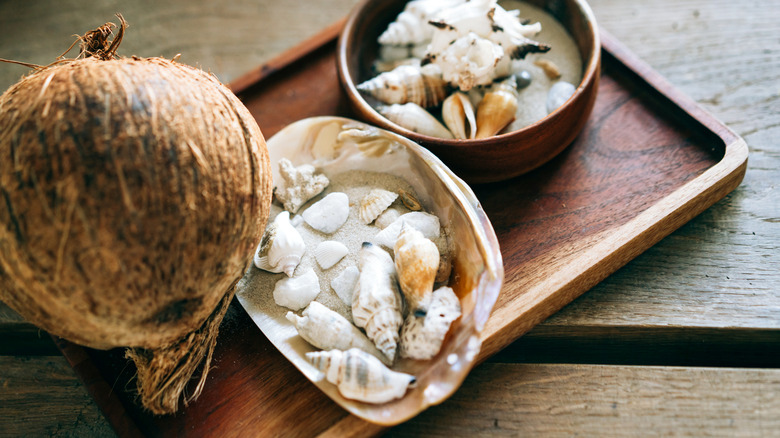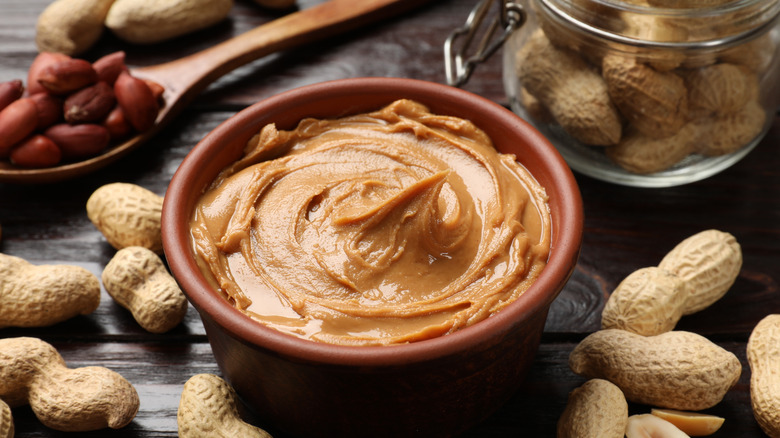The Clever Way An Old Seashell Can Bring More Beautiful Birds To Your Yard
We may receive a commission on purchases made from links.
Waking up to sweet birdsong in the morning is just one of the benefits of having a bird feeder in your yard. Birds are delightful garden visitors who benefit your plants, keep the insect population under control, and are fun to watch. If you find it hard to resist picking up seashells when visiting the beach, upcycling them to create a unique bird feeder not only attracts birds, but gives your beach treasure a purpose.
To make a quick, temporary feeder for smaller birds, grab an apple, some smaller shells such as limpets or clam shells, and string. Core the apple to create a hole through the center, feed the string through the hole, and leave enough length to suspend it at the height you want; birds enjoy suspended feeders since they tend to sway and move, much like branches do naturally. Press the sharp edges of your shells into the flesh of the apple, creating small bowls. You can vary the level, but make sure to keep them at the same angle to prevent the seed from tipping out. Tie the shelled apple in place and fill each shell with fine birdseed, such as Wild Harvest advanced nutrition diet canary and finch seed mix; birds love snacking on the seeds and the apple itself.
Multi-level hanging bird feeders using upcycled shells
Stacked, multilayer birdfeeders are great as you can accomodate many visitors at the same time. These work well with larger shells that have a reasonably flat surface area such as oyster shells. There are a couple of ways to suspend them, with the first using macramé. While this TikToker creates a single level and uses a can for the bird bowl, you can triple the measurements and keep adding more levels before tying off your thread. Replace the can with shells and fill them with wild bird food and water.
You can also crochet a granny square patterned tile to hold each oyster shell; use natural colors to blend in with the surroundings and make your square just big enough to cradle the shell. You can buy extra shells if necessary, such as the 25-piece Qeqekaka oyster shells for crafts. Use a single row of chain stitch from each corner to create the suspension cords, attaching each level to the one above by threading the wool through a corner hole and tying it off to make as many levels as you like. If all this knot-tying ties your stomach in knots, you can use chains and rings to create your shell shelves by drilling holes into them or carving holes out using a small, sharp knife and patience.
Use sticky seeds and seashells to bring the birds
Pair shells such as mussels, clams, or oysters with a peanut butter suet to draw in a feathered crowd. Start by choosing from the five types of bird seed to attract your favorites, combine the seeds with 100% pure peanut butter such as 365 by Whole Foods Market organic creamy peanut butter. Mix your ingredients, making sure there are no blobs of unseeded peanut butter that could stick to birds' beaks or feathers, and set it aside while you prepare the feeder.
Find a thick, solid branch that is light enough to suspend from a tree or your porch, with bonus points if it has smaller branches that the birds can use for perches. Glue the backs of your shells to the wood, positioning them with sufficient space between that the birds can enjoy semi-private dining. Once the glue is dry, fill the hollow side of each shell with the peanut butter suet. If there are no natural perches on your branch, add some by gluing on strong twigs, positioning them near your shell feeders. A variation of this design is to glue shells to a horizontal plank of wood: Drill a single hole at either end of the plank wide enough for a rope to fit through, then tie the rope beneath the plank with a large knot that can't slip through the holes. Fill and hang your feeder to enjoy feeding time!

